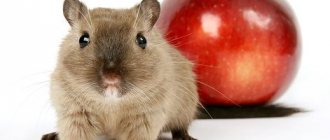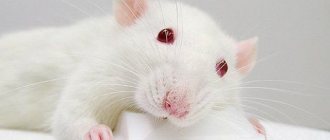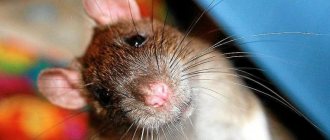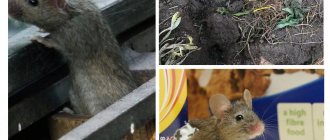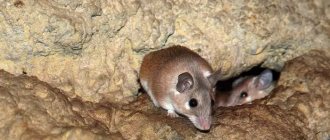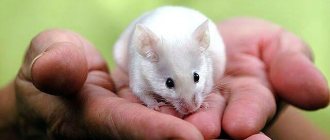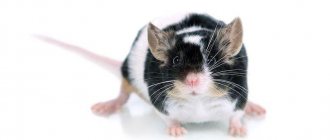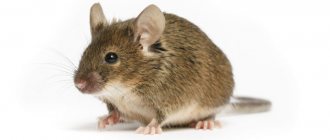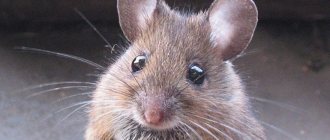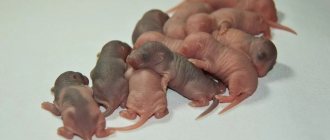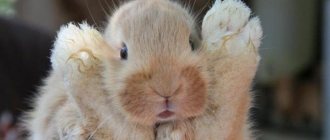Almost every person has acquired a pet at least once in their life. Some prefer common types of pets such as cats and dogs. Some people like exotic reptile species. Well, some owners keep a white mouse as a pet.
has been considered a pet for many years . The origin of these cute animals is controversial. Some sources indicate that the decorative mouse existed before our era. But a more common description of the origin of these mice points to the breeding of ornamental rodent species in laboratories for experiments.
Previously, in many countries there was a belief that if there is a white mouse in the house, it will protect the house from other rodents that can leave the owners without food supplies in a short time. Our ancestors also associated these cute animals with joy. To this day, many people have a favorable attitude towards this decorative animal.
Description of domestic decorative mice
Decorative mice are small and very cute pets. There are different types of these rodents, among which you will definitely find your favorite.
Appearance
These animals are small long-tailed rodents. As a rule, their body length does not exceed 10 cm. Their weight can be 12–30 g. Breeders have worked for many years to develop different types of mice.
Rodents can have different types of fur:
- curly;
- long;
- short;
- satin;
- bald.
House mice are also divided into:
- short-tailed;
- long-tailed
If we talk about the color of these rodents, they can be divided into the following groups:
- single-color (brown, black, white, gray, etc.);
- spotted (striped, with colored specks, etc.);
- multi-colored (gray-blue, gray-silver, as well as colors typical of chinchillas, sables, Persian cats, etc.).
Did you know? Mice's joints are similar in structure to those of humans. The number of parts they consist of is the same as that of humans.
Characteristics
Homemade decorative mice are ideal for those people who spend little time at home, cannot pay much attention to the animal, but really want to have a pet. These rodents do not require training, regular walking or educational processes.
Mice quickly get used to a new place, adaptation is painless for the animal. If you treat your pet with care, it becomes tame. Over time, he begins to recognize his owner. Rodents lead an active lifestyle. As a rule, this happens at night; mice sleep during the day. They are cheerful and rarely give up playing. These pets live on average 2 years. Life expectancy depends on the conditions of their detention.
Place of detention
The habitat of mice covers almost all climatic zones, continents and zones, with the only exception being Antarctica. Their various species are found in forests, taiga, tropics, steppes or swamps. Therefore, what such animals eat depends on their habitat and environment.
The smallest mice, such as shrews, can be only 5 cm in length, but there are also those that grow up to 50-80 cm. The color can also vary: from white, gray, brown to black. Females become fertile at the age of 6 weeks and are able to give birth to 5-10 babies in each litter.
Mice in natural conditions feed on what they find around: cereal seeds brought from agricultural fields (wheat, barley, oats, etc.), small insects or their larvae. Living in minks, the mouse in the meadow eats not only grain, but also clover and green parts of plants.
Wild forest mice eat berries and fruits of plants, as well as nuts, mushrooms, acorns, and tops. Swamp inhabitants prefer to feed on various parts of plants: buds, roots, leaves and shoots. They eat caterpillars and grasshoppers with no less pleasure.
The construction of nests and filling of bins continues until the onset of frost. During the cold season, field mice eat what they have accumulated in their burrows; they often eat small insects, worms, crickets, beetles and their larvae.
The presence of water is very important in their diet, which they need up to 3 ml per day for normal life. Consuming only dry food without water, these animals die within 2 weeks.
Cannibalism is very rare among small pests. Large mice eat mice only in a situation where they are confined in a limited space or when an unfamiliar individual appears in the group. In the wild, various species exist quite peacefully.
However, the fact that these animals eat their own kind is reliable when raising offspring. Most often this occurs from a lack of vitamins and improper nutrition of the mother, as well as from the birth of a non-viable baby or too many offspring that the mother is not able to feed and is forced to eat.
For the digestive system to function properly, the air must be heated to 30 degrees, otherwise the animal will die. His body temperature is not constant and depends on movement activity.
In the habitat, temperature indicators must change more than once a day. This problem is solved by dividing the enclosure into compartments, partitioned with a metal mesh, leaving holes in it.
The device will allow the resident to choose a comfortable mode himself.
A rectangular metal cage is best. It should be of such a size that your pet can move around freely and have room to do so. Gaps and wooden elements in the cage structure are simply unacceptable in this case.
The bottom of the house is covered with shavings. An excellent necessary addition would be houses, pots, a feeder, and a drinking bowl. Don't forget that the mouse will certainly want to play.
Varieties
House mice have a huge number of species. The most famous include:
- Little ones. Such rodents are the smallest mammals in Europe. They are red or brown. The abdomen of these pets is white or gray. The animals grow up to 13 cm in length. They are distinguished from other breeds by the shortened shape of their muzzle.
- Gerbils. Externally, this species resembles chipmunks. They are characterized by a short tail and a relatively large body when compared with other similar rodents.
- Needle mice. Pets of this breed may remind you of hedgehogs. The shape of their fur is like needles. It is this feature that greatly distinguishes these animals from other types of rodents. In addition, they are distinguished from other pets by the appearance of their eyes. They are black in color and have a round convex shape.
Reason for choosing a mouse
Decorative pet mice are an ideal option for those who have decided to have their own animal or teach a child to take care of the weak, but are limited by time, funds and square meters.
You can squeeze the mouse
Unlike phlegmatic fish - other inhabitants that do not take up much space - they are able to respond to affection: you can stroke them, feel the warmth of a small body in a fur coat, they are quite affectionate and enjoy sitting in your arms.
Varieties: mouse and mouse are different
Oddly enough, tamed and domesticated mice are divided into only two types. The first species is the albino mouse, also known as the white laboratory mouse. The decorative house mouse is an animal weighing on average 30 grams. with a body 7-12 cm, a tail of the same length, hard, medium-length fur, often one-color: black, brown, gray, sandy color. The lifespan of this miniature animal is on average 2-3 years.
White mouse
The white mouse stands apart - the ancestor of the entire mouse movement. Bred before our era, this creature was a frequent guest in the homes of Chinese emperors, and later, brought to England, quickly won the sympathy of all pet lovers.
In the 19th century, they were attracted to participate in laboratory experiments, as a result of which a separate species appeared - the laboratory mouse. She was bred to participate in laboratory experiments to study social behavior patterns, test medications, and much more that directly benefits humanity. For pet lovers, this species is not so attractive, although albino mice can still be found in city apartments.
Each animal needs its own special space, which it will consider “its place” - sacred and inviolable. Therefore, before you bring mice home, you should take care of where they will live. It was before, not after. Because jars and cardboard boxes are absolutely not suitable for rodents. And any move is always stressful.
Avoid aquariums as well. They are cramped, stuffy, hot, the mouse will not be able to move normally in them and arrange a secluded corner for itself. The best solution would be a spacious cage with metal bars.
Rodent cage
Be sure to make it yourself or buy a small house - a hole where the mouse will spend all day long.
Add a wheel to provide your pet with physical activity and fulfill his need for movement. For the same purpose, take care of shelves, ladders and ropes. The animal will be happy to show you its dexterity, and you will also have fun watching its amusing movements.
Sawdust for rodents
Litter is a very important element. The layer should be quite impressive - at least 5 mm. Animals use it not only for its intended purpose, but also to decorate their house, and when there are drafts or low temperatures, they burrow into it to keep warm.
The material should be natural and preferably inexpensive: sawdust, dry peat crumbs, shavings, hay. Avoid cotton wool and sand - the first absorbs odors too well and gets tangled between your fingers, and the second can become a breeding ground for lice. But something tells us that you don’t want such neighbors.
Habitats and lifestyle in nature
Mice live on all continents of the globe, except Antarctica. As a rule, they live in deciduous and coniferous forests, steppe zones, mountains, tropical thickets and swampy areas. They also settle in people's houses.
These rodents make nests for themselves. For this they use dry grass stems. The above mammals are capable of creating a complex system of underground passages in order to live in it. They often occupy existing burrows. Species of these animals that live in swamps can swim, unlike those that live in other areas.
Also learn how to tell a mouse from a rat.
In Russia, mice are common. They do not live only in the northern part of Siberia, in the mountain tundras, on Taimyr and near the Lena and Yenisei rivers.
Dental system
Rodents have well-developed incisors: two pairs on each jaw. The front teeth have no roots and grow throughout the mouse's short life. To prevent excessive growth, mice must constantly grind them down. The upper incisors are much larger than the lower ones, and are covered with durable enamel on the front.
Pests do not have fangs; instead, the jaw has a toothless edge - a diastema, behind which there is a palisade of molars. With their help, food is ground and crushed. The surface of some teeth is smooth, while others are covered with tubercles. Like incisors, molars are constantly growing and need to be ground down. Tree branches are perfect for these purposes.
When trying to gnaw on something metal or hard, the lower incisors may break, which leads to an incorrect bite: the teeth of the upper jaw bend inward, the animal is unable to close its mouth, cannot eat, and as a result dies from starvation.
Rules for keeping at home
We must always remember that people are responsible for those they have tamed. All animals living in the home need proper care, and rodents are no exception. This will be discussed in more detail later in the article.
What should a cell be like?
It is much easier to keep such a pet than, for example, a dog or a cat. A decorative mouse will not take up much space. She spends most of her life in a cage, so she will not claim the personal space of her owner.
Basic requirements for the cage:
- The area for the rodent should not be less than 20 cm².
- Durable material of construction (e.g. iron). If the home is made of wood or plastic, then the mouse can easily gnaw through it.
- No sharp elements.
Home improvement
In order for your pet to feel comfortable and not get bored, it is necessary to properly arrange its home. You need to put a small layer of shavings or sawdust on the floor of the cage. The feeder and drinker should be placed in an easily accessible place so that your hand can get to them. Containers for food and water need to be washed daily, so they should not be deep in the cage.
Important! The cage should be located away from the window and air conditioner. Drafts and cold have a detrimental effect on the animal.
Rodents are very playful creatures. Their space should be equipped with toys. A running wheel and various pipes are ideal for this. You can make several floors or rooms in a cage. The animal will be interested in changing the environment.
Nutrition
Unlike other pets, decorative mice are unpretentious in their diet. They primarily eat grain mixtures, which may include:
- pea cereal;
- wheat;
- oats;
- barley;
- cake;
- flax or sunflower seeds;
- millet.
Rodents will also never refuse such products as:
- apples;
- carrot;
- various nuts;
- cabbage;
- beet;
- cucumbers;
- potato;
- dried fruits;
- porridge (wheat, oatmeal, rice).
You cannot give pets:
- candies, chocolate;
- preservatives;
- smoked meats;
- spicy and fatty foods.
You should always remember that these pets need to have their incisors ground down. For this purpose, it is recommended to periodically place lignified twigs in their cage.
Important! It is forbidden to allow domestic decorative mice to come into contact with lilacs, since it contains elements that are toxic to these creatures.
Content issues
Keeping decorative rats has its own difficulties. Most often they are associated with the peculiarities of the lifestyle and habits of rodents. Problems that may arise:
since in nature rats are most often nocturnal, pets often make noise at night; decorative rats have rather poor health, you need to be prepared for periodic visits to the veterinarian; domestic rats need constant attention and communication with the owner, otherwise they will become unbalanced and may even bite people; rats try everything, so when a pet goes for a walk around the house, it can chew wires, books, furniture, and things.
Tooth test
From time to time the rat needs to be released from the cage, but sometimes it is very difficult to ensure that the animal does not crawl into some opening, for example, into a ventilation shaft or the place where the network cable enters. If this happens, the pet may disappear forever into the bowels of the building.
How to properly care
Pet care should be carried out regularly. Leftover food and trash must be removed every day. The litter is changed several times a week, depending on its condition. To keep your animal healthy, it is important to keep the feeder and drinking bowl clean. The water must be constantly clean.
Water treatments
Due to the fact that these creatures are clean, they are easy to care for. Water procedures should only be carried out if the animal is very dirty, since mice are afraid of water. Before you wet the fur, you need to make sure that this is the only way to clean the animal, and a regular brush will not help.
During water procedures you cannot:
- use shampoos and cosmetics not intended for mice;
- allow water to get into your eyes or ears;
- wash under running water;
- take a lot of water into the bathing bowl;
- talk loudly, as this can cause even more stress for your pet;
- leave the window open and allow a draft in the room where bathing takes place.
Read more about how to determine the gender of a mouse.
Claw treatment
Decorative house mice rarely need to have their claws trimmed. As a rule, they grind them down themselves. But if you see that the animal needs help, it begins to limp, it is difficult for it to move, then in these cases you need help. First you need to carefully examine the paws. If you are convinced that the claws are too long and are in the way of the rodent, they should be trimmed.
For this procedure, it is recommended to use a nail clipper designed for pets (cats, small breeds of dogs). You need to trim very carefully so as not to touch the nail bed and cause pain to your pet. This must be done in such a way as to preserve the natural shape of the claws.
Diseases
Like all animals, mice can get sick. Basically, all diseases of ornamental mice arise from improper maintenance. For example, due to low humidity in the environment, a mouse can develop tail ring syndrome, where ring-shaped sores appear on the tail. Therefore, it is better to keep the cage where the humidity levels are 50-55%.
Mice also suffer from pneumonia, salmonellosis, which, by the way, can be transmitted to humans, mousepox, otitis media and many other diseases, and some of them, unfortunately, cannot be treated. It often happens that a mouse dies within two days during illness. Not all diseases can be seen by symptoms, but some symptoms need to be known because they are not typical for a healthy mouse, namely:
- weight loss;
- ulcers on the body;
- frequent urination;
- blood in stool;
- partial baldness.
It is important to monitor the animal’s living conditions and immediately contact a veterinarian if any of the above symptoms are detected.
Reproduction of decorative mice
These animals reproduce very actively. Pregnancy lasts about 20 days. During this period, the female tries to build a nest in the cage; as a rule, the material is sawdust and shavings from the floor. The owner can place hay, small pieces of toilet paper or napkins in the pet’s home. The mouse quickly uses them for its nest.
One female can give birth to up to 15 pups. Childbirth goes very quickly. During the first days, small rodents resemble red spots. The offspring should not be touched with hands, since the mother may then not accept them and stop feeding them due to the fact that she will smell someone else’s smell. After giving birth, you must approach the cage for three days only to change the water and add food. 4 weeks after birth, the mouse reaches puberty.
Did you know? In countries like Vietnam and Rouen, mice are considered a delicacy. People eat dishes made from these animals with great pleasure.
Setting up a cage for mice
To make your mouse cozy and comfortable, you need to purchase a spacious cage, which can be made from both natural and synthetic materials. The best option would be a rectangular cage with metal bars and a wooden base. The height of the cage is at least 50 cm, and the floor dimensions are 40x40 cm.
This space is enough for one mouse seed to sit comfortably in the cage. To observe the life of your tailed pets, it is best to install transparent houses and tunnels in their home.
The cage must be equipped with a feeder and an automatic drinker. This will allow you to maintain a certain cleanliness in the mouse house, since your pets will knock over food and spill water. It is best to fill the bottom of the cage with fresh sawdust.
If there is only one pet in the cage, then the smell from it will be almost invisible. But when keeping a mouse family, it is best to use a false bottom in the cage. In this case, through small holes on the floor in the cage, feces will be poured onto a special tray, which will allow you not to bother yourself with daily cleaning.
